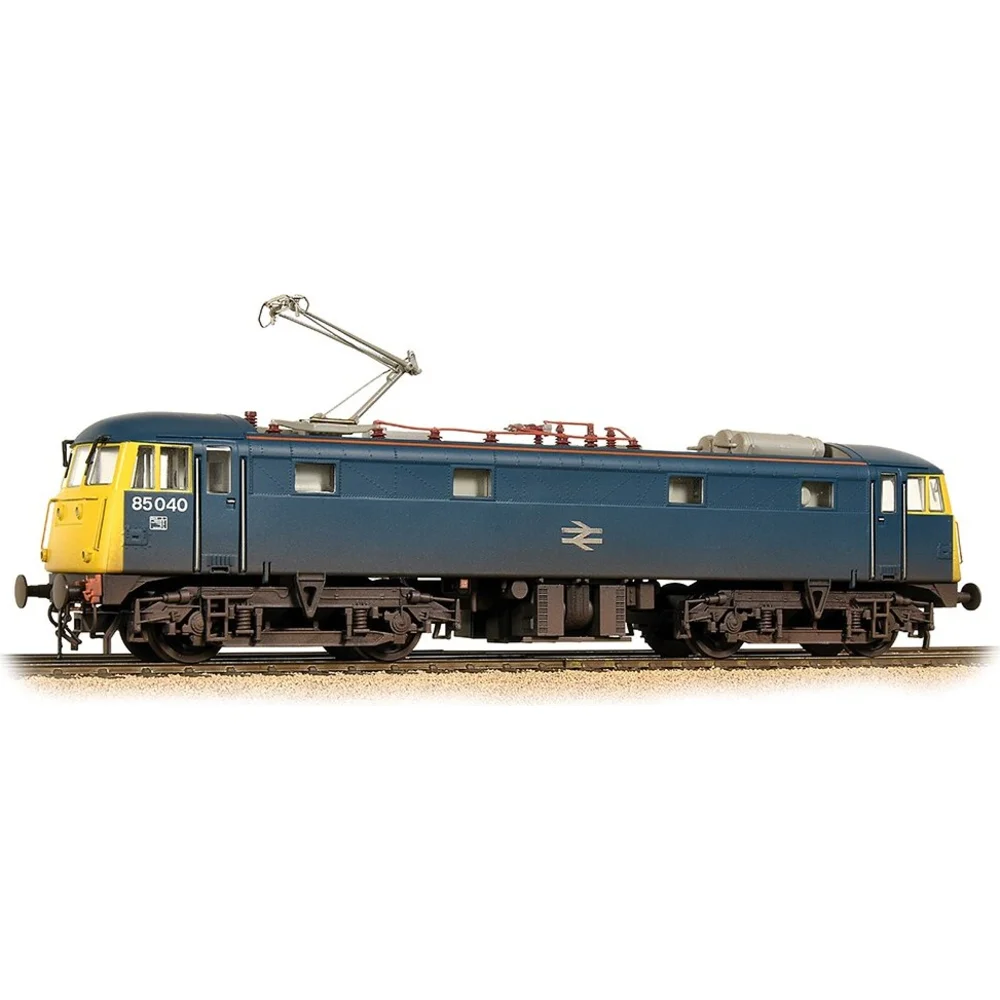Bachmann 31-678A
British Rail Class 85 85040 British Rail Blue
Tooling
Announced in 2012, Bachmann’s British Rail Class 85 marked the company’s first UK-outline AC electric locomotive in OO gauge. The prototype Class 85, originally designated AL5, was built between 1961 and 1964 for the electrification of the West Coast Main Line. Bachmann’s decision to produce this model filled a long-standing gap in the market for accurate AC electrics, following mixed reception of earlier models from other manufacturers.
Tooling Features
- Construction: Combination of plastic and metal components for durability and weight.
- Detailing: Factory-fitted separate details including handrails, bufferbeam detail, roof-mounted electrical equipment, Stone Faiveley AMBR pantograph, window wipers, and fully detailed cab interior.
- Couplings: NEM pockets with tension-lock couplers; cosmetic screwlink couplings supplied in accessory pack.
- Buffers: Sprung metal buffers.
Mechanical & Electrical
- Motor & Drive: Centrally mounted motor driving all axles via a gear train.
- Lighting: Directional headlights and tail lights, plus cab lighting.
- Weighting: Integrated into chassis for smooth running and traction.
DCC Capability
- DCC Ready with a 21-pin socket.
- Provision for sound installation with speaker connections on PCB.
- Lighting functions controllable via decoder (F0 for headlights/tail lights, F1 for cab lights).
Liveries Produced
- BR Electric Blue (early condition).
- BR Blue (TOPS era).
- Railfreight Distribution triple grey (limited edition).
- Weathered variants of BR Blue.
Reviews & Commentary
The model was widely praised for its accurate body shape, fine detailing, and exceptional roof equipment, particularly the pantograph which was considered superior to previous offerings. Running performance was reported as smooth and reliable. Minor criticisms focused on pantograph adjustment and calls for finer-scale grilles in future reissues. Enthusiasts on RMweb and YouTube highlighted its appeal as an essential addition for West Coast Main Line layouts, with many fitting sound decoders for enhanced realism.
Interesting Notes
- The tooling included poseable pantographs and etched cab emblems.
- Accessory packs provided additional detailing parts for bufferbeams and pipework.
- The model was considered a turning point for AC electric representation in OO gauge.
Class & Prototype
- Class: British Rail Class 85
- Traction: Electric
- Built: 1961-1964
- Total Built: 40
No prototype found.
Operator & Livery
- Operator: British Rail
- Livery: Blue
British Rail (1965-1997) transformed Britain's railways through revolutionary modernisation, introducing the iconic double arrow logo, Rail Blue livery, and business sectorisation. BR pioneered high-speed rail with the InterCity 125 and Advanced Passenger Train, electrified major routes, and created profitable divisions like InterCity and Network SouthEast. From steam succession through diesel and electric development to privatisation preparation, British Rail's diverse locomotive fleet, multiple livery schemes, and operational scenarios provide unparalleled variety for railway modellers across all scales and periods.
BR Blue, also known as Rail Blue or Monastral Blue, was introduced in 1965 as part of British Rail's comprehensive corporate identity overhaul that accompanied the rebranding from British Railways to British Rail. The colour was officially defined by British Standards BR28/6001 (airless spray finish) and BR28/5321 (brush finish), representing a dark, greyish blue tone specifically chosen to hide dirt and weathering effects well.
The livery was prototyped on the experimental XP64 train in 1964 before becoming the standard scheme from 1 January 1965. Rail Blue was applied to all diesel and electric locomotives with yellow warning panels (initially small, then extending to full yellow ends from 1966). The standardised application included the iconic double arrow logo and Rail Alphabet typeface, creating one of the most successful transport corporate identities of the 20th century.
The livery dominated British Rail operations for over two decades until sectorisation in the 1980s began fragmenting the unified appearance. Despite initial colour fading problems in early applications, these were resolved by the late 1970s when the Large Logo variant was introduced featuring extended yellow areas and full-height double arrow symbols. Rail Blue's enduring appeal among railway enthusiasts reflects its role as the definitive British Rail image during the organisation's most unified period.
